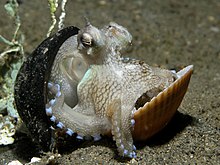Amphioctopus marginatus: Difference between revisions
m r2.7.2+) (Robot: Adding ceb:Octopus striolatus |
m r2.6.5) (Robot: Adding war:Octopus striolatus |
||
| Line 55: | Line 55: | ||
[[pt:Amphioctopus marginatus]] |
[[pt:Amphioctopus marginatus]] |
||
[[sv:Octopus striolatus]] |
[[sv:Octopus striolatus]] |
||
[[war:Octopus striolatus]] |
|||
[[zh:条纹蛸]] |
[[zh:条纹蛸]] |
||
Revision as of 06:13, 14 February 2013
| Amphioctopus marginatus | |
|---|---|

| |
| Scientific classification | |
| Kingdom: | |
| Phylum: | |
| Class: | |
| Order: | |
| Family: | |
| Genus: | |
| Species: | A. marginatus
|
| Binomial name | |
| Amphioctopus marginatus (Taki, 1964)
| |
| Synonyms | |
| |
Amphioctopus marginatus, also known as the coconut octopus and veined octopus, is a medium-sized cephalopod belonging to the genus Amphioctopus. It is found in tropical waters of the western Pacific Ocean. It commonly preys upon shrimp, crabs, and clams, and displays unusual behaviour, including bipedal walking and gathering and using coconut shells and seashells for shelter.
Size and description
The main body of the octopus is typically around 8 centimeters (3 in) in size, and, with arms, approximately 15 centimeters (6 in) long. The octopus displays a typical color pattern with dark ramified lines similar to veins, usually with a yellow siphon. The arms are usually dark in color, with contrasting white suckers. In many color displays, a lighter trapezoidal area can be seen immediately below the eye.
Behavior and habitat

The coconut octopus is found on sandy bottoms in bays or lagoons. It frequently buries itself in the sand with only its eyes uncovered.[citation needed]
In March 2005, researchers at the University of California, Berkeley, published an article in Science in which A. marginatus was reported to have a bipedal behavior.[1] It is one of only two octopus species known to display such behavior, the other species being Abdopus aculeatus. According to the article, this behavior was discovered in an area off Sulawesi, Indonesia, where the sandy bottom was littered with coconut shells. The bipedal motion appears to mimic a floating coconut.[2]
Researchers from the Melbourne Museum in Australia claimed the creature's use of tools for defense, and the use of available debris to create a defensive fortress. This behavior, observed in Bali and North Sulawesi in Indonesia between 1998 and 2008, was published in the journal Current Biology in December 2009.[3][4][5] The researchers filmed A. marginatus collecting coconut half-shells, discarded by humans, from the sea floor, carrying them up to 20 meters (66 ft), and arranging the shells to form a spherical hiding place akin to a clamshell.[4][6] The authors claim this behaviour to fall under the definition of tool use because they claim the shells are carried for later use. However, this argument does not hold up to scrutiny in light of the predator environment in which A. marginatus lives. Amphioctopus marginatus lives in soft-sediment areas with many bottom-dwelling predators, such as scorpionfish and flounders, that often bury into the sand and cannot be seen or easily avoided. The coconut shells provide constant protection from potential attacks from below while moving along the bottom. Thus, the claim of tool use is not upheld[citation needed].
See also
References
- ^ Sanders, Robert: Octopuses occasionally stroll around on two arms, UC Berkeley biologists report, University of California, Berkeley, March 24, 2005.
- ^ Christine L. Huffard, Farnis Boneka, Robert J. Full: Underwater Bipedal Locomotion by Octopuses in Disguise, Science, March 25, 2005.
- ^ Finn, Julian K.; Tregenza, Tom; Norman, Mark D. (2009), "Defensive tool use in a coconut-carrying octopus", Curr. Biol., 19 (23): R1069–R1070, doi:10.1016/j.cub.2009.10.052, PMID 20064403.
- ^ a b Gelineau, Kristen (2009-12-15). "Aussie scientists find coconut-carrying octopus". The Associated Press. Retrieved 2009-12-15.[dead link]
- ^ Harmon, Katherine (2009-12-14). "A tool-wielding octopus? This invertebrate builds armor from coconut halves". Scientific American.
- ^ Henderson, Mark (2009-12-15). "Indonesia's veined octopus 'stilt walks' to collect coconut shells". Times Online.[dead link]
External links
- "CephBase: Amphioctopus marginatus". Archived from the original on 2005-08-17.
- Octopus uses coconuts - Video via EducatedEarth
- Octopus marginatus at National Center for Biotechnology Information (NCBI)
- News
